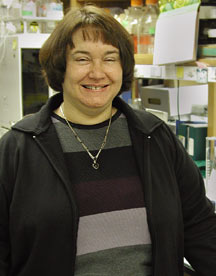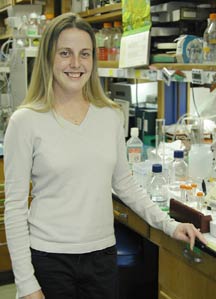Mysterious gdT Cells Promote
Wound Repair
By Jason Socrates
Bardi
[He
took] from thence a Rib, with cordial spirits warme, And
Life-blood streaming fresh; wide was the wound, But suddenly
with flesh fill'd up & heal'd
———John
Milton, Paradise Lost, 1667
At the roots of some of the most symptomatically unrelated
chronic human health problems like wheezing, itchy skin, and
diarrhea are biologically similar inflammatory diseases of
the "epithelial" outermost layers of the lung, gut, and skin.
Diseases like asthma, psoriasis, and ulcerative colitis
are all caused by adverse inflammation of their respective
epithelial tissues, and the key to treating some of these
diseases may come from understanding a single type of immune
cell that resides mainly in these epithelial tissues—the
heretofore mysterious gd T cell
(pronounced "gamma–delta").
Scientists had for years postulated various biological roles
for the cells, and many researchers had sought to determine
how they might be involved in diseases. Until now these studies
only deepened the mystery of the gd
T cell. Recently, the first major biological role of this
cell was identified by scientists at The Scripps Research
Institute (TSRI), and the story goes that these cells play
a major role in promoting wound repair.
"Very little has been known about the function of these
cells until now," says TSRI investigator Wendy Havran, who
is an associate professor in the Department of Immunology
at TSRI and has been studying gd
T cells for several years. She led the effort that detected
this novel function of gd T cells.
A Cell of Known Origin but Unknown Function
What had been learned of gd T
cells in the nearly two decades since their initial discovery
was that they arise early in fetal development in the thymus.
From there, they migrate to epithelial tissues—the thin
layer of cells that makes up the outermost layers of skin
and lines organs like the intestines and lungs.
Unlike the canonical T cells of the immune system, the "white
blood" ab T cells in blood, most
gd T cells do not circulate through
the bloodstream. Instead, they are the major T cell component
of the skin, lung, and intestine, where they take up residence
and monitor the neighboring epithelial cells for damage and
disease. Some gd T cells, however,
do circulate in the bloodstream and may carry out completely
different biological functions than the skin gd
T cells.
Though gd T cells are the first
T cells the thymus produces, this organ nearly shuts off production
of them later in development. Throughout life, the body maintains
its population of gd T cells "on-site,"
allowing them to divide as needed.
In the epidermis where the gd
T cells are concentrated, numbering half a thousand cells
per square centimeter, they have a spiny, stretched-out, finger-like
shape that contacts as many skin cells as possible.
Also unlike other T cells in the body, which display a wide
diversity of receptors that recognize a wide diversity of
antigens—the molecular components of various pathogenic
invaders—the gd T cells in
the skin seem to have little, if any, diversity and display
a uniform receptor and recognize only a single antigen.
This recognition event appears to be crucial for mediating
wound healing.
Activated by Keratinocytes
"When wounds heal, the epithelial cells in the skin have
to proliferate and fill in the wounds," says Havran. She found
in a recent study with Research Associate Julie Jameson that
gd T cells help this proliferation.
The study, "A Role for Skin gd
T cells in Wound Repair" by Julie Jameson, Karen Ugarte, Nicole
Chen, Pia Yachi, Elaine Fuchs, Richard Boismenu, and Wendy
L. Havran was published in the April 26, 2002 issue of the
journal Science. It showed that when skin is cut or
damaged, keratinocytes, which are the major type of epithelial
cell in the epidermis, are able to faster re-epithelialize
tissue that has been wounded if they can get help from the
gd T cells.
Havran and Jameson postulate that the keratinocytes, sensing
the damage, release an antigen that is recognized by the gd
T cells, which then become activated. Once activated, the
gd T cells undergo a morphological
change and become little round factories. These begin mass-producing
a growth factor that binds to keratinocytes and other epithelial
cells, helping them proliferate and leading to the closure
of the wound. The gd T cells also
proliferate, multiplying to increase the response to the wound.
1 | 2 |

|

Wendy Havran, associate professor in
the Department of Immunology at TSRI, has been studying gd
T cells for several years. Photo by Kevin
Fung.

Research Associate Julie Jameson was
first author on the study. Photo
by Kevin Fung.
|

